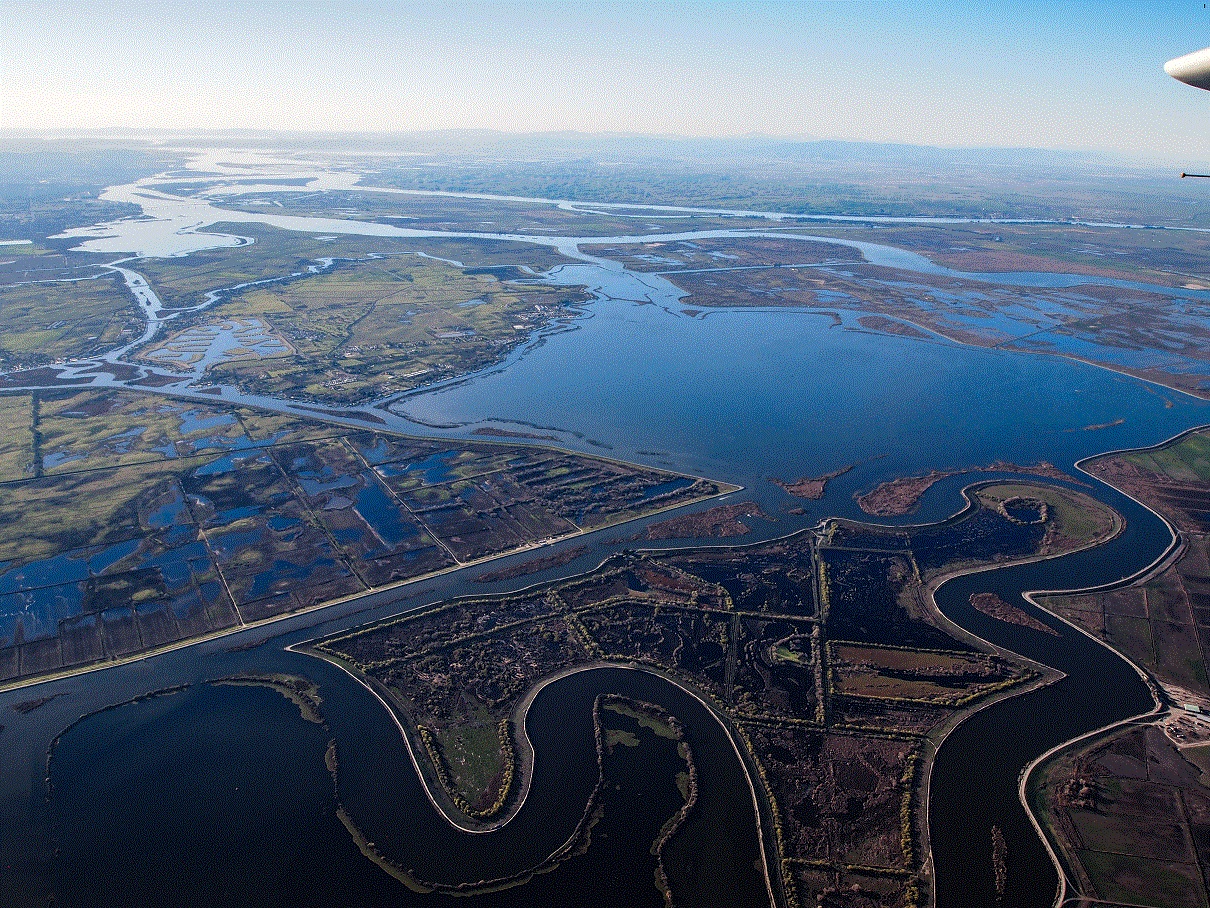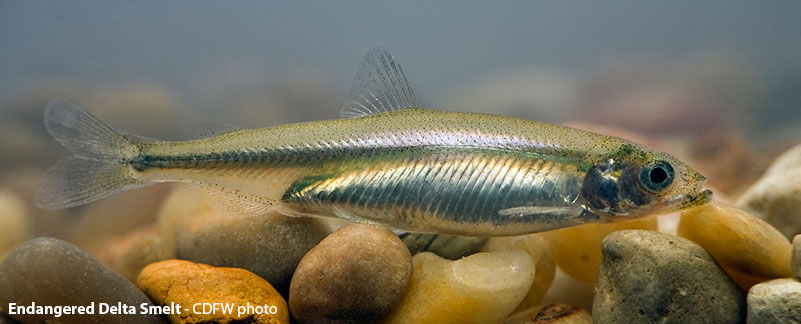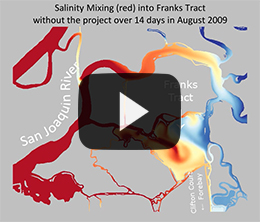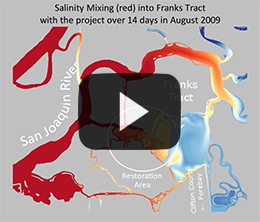Update
 Franks Tract & Little Franks Tract facing westward (CDFW Photo)
Franks Tract & Little Franks Tract facing westward (CDFW Photo)
Franks Tract Reimagined (PDF)(opens in new tab) was completed in September 2020. The project was a
collaborative planning process initiated by the California Department of Fish
and Wildlife as part of the 2016 Delta Smelt Resiliency Strategy. The process entailed
working with the local community, local agencies, and interested stakeholders
to develop a habitat enhancement plan for Franks Tract using a transparent and
collaborative process that addresses local concerns.
Franks Tract Reimagined presents and documents the outcomes of a year long planning
effort driven by a local advisory committee using a structured decision making
process, to identify a conceptual restoration project which could meet both
ecological and local interests.
In July 2019 the Department in cooperation with the Department of Parks and Recreation launched a second round of planning for possible future restoration of Franks Tract. This effort built on the lessons learned from the original feasibility study and guidance from the Delta Conservation Framework. Based on the initial study Phase II was focused on direct engagement with the local and affected communities to develop a project which can meet multiple objectives and achieve broad support. The desired outcome was that the final plan achieved biological and water quality objectives and addressed local concerns related to recreation, navigation, flood protection, and local economic sustainability. The planning was conducted by a multidisciplinary team of led by Environmental Science Associates, with outreach provided by U.C. Davis and modeling support by the Department of Water Resources. The planning effort was completed in December 2020. The primary Phase II website(opens in new tab) serves as the central hub for public involvement and planning information.
Background
The 2016 Delta Smelt Resiliency Strategy (PDF)(opens in new tab) identified a number of actions to be implemented to improve conditions in the Delta for the declining state listed endangered and federally listed species. As a result of the extended drought between 2013 and 2015 Delta Smelt abundance had declined to historic lows. The Strategy identified thirteen management actions including development of the Franks Tract Restoration Feasibility Study. The Department of Fish and Wildlife is the lead for preparing the study.
The objective of the Franks Tract study was to assess the feasibility of restoring components of the historic tidal marsh form and function to create habitat suitable for Delta Smelt guided by A Delta Renewed(opens in new tab). Key restoration objectives include reducing the extent of aquatic weeds, decrease predation on Delta Smelt and other native fishes by lowering habitat suitability for non-native species, modifying hydrology to something more similar to historical conditions, and improve food webs.
Franks Tract and Little Franks Tract are flooded islands in the Central Delta located in northeastern Contra Costa County adjacent to the community of Bethel Island. The 3,532 acre area, flooded by levee breaches in 1937 and 1982, is currently shallow open water habitat and remnant levees managed as part of the Franks Tract State Recreation Area.
Franks Tract is one of the most popular and heavily used areas of the Delta. Neighboring Bethel Island hosts numerous bass fishing tournaments, including some of national importance. These tournaments and associated recreational boating directly affect the sustainability of the local communities.
Franks Tract Futures?, the final feasibility study report, summarizes the restoration concepts developed to date, early stakeholder feedback, and results of initial hydrodynamic modeling and engineering studies including preliminary cost estimates. Findings conclude that it is feasible to restore portions of Franks Tract to improve habitat conditions for Delta Smelt and other native and pelagic fish species. Restoration has the potential to enhance water quality in the central and south Delta, reduce the extent of aquatic weeds, and limit the entrainment of fish from the west Delta into the south Delta.

Invasive species control has been identified as a high priority component of a Central Delta Corridor vision, and as an important near-term action within this corridor. Improving habitat for endangered Delta smelt populations is another primary focus of the vision, as has been outlined in the Delta Smelt Resiliency Strategy.
Franks Tract currently facilitates salinity intrusion into the mid-Delta as a result of tidal pumping through False River. Restorations designs focus on minimizing tidal pumping from False River, an important mechanism of salinity intrusion. Two video animations—one of the existing Delta salinity intrusion (YouTube)(opens in new tab) in the summer, where saline water from San Francisco Bay is entering and exiting the central Delta with the tides, and a simulation with a restored Franks Tract (to be posted soon) as well as a simulation of the locally developed scenario, also in summer—provide conceptual illustrations of how tidal pumping of saline water works with and without a restored Franks Tract. On flood tide, a jet of higher salinity (red) water is seen entering Franks Tract from False River through an aperture sometimes referred to as a nozzle. Water quality in this jet is heavily influenced by that of the San Joaquin River at Jersey Point which is saltier than most of the Delta and Franks Tract. The return flow from Franks Tract is fresher—the salty jet of water will have mixed out somewhat and the ebb flow is drawn radially from a broader area so it includes more of the ambient water in Franks Tract.
 Existing Delta salinity intrusion video
Existing Delta salinity intrusion video
 Restored Franks Tract video (to be posted soon)
Restored Franks Tract video (to be posted soon)
Even if the volume of flow is the same in both directions, the asymmetry between a salty flood and fresher ebb adds up and causes a net transport of salt into the Delta — like a bus that travels both north and south, but carries many more passengers in the southern direction. The restoration approach developed as part of Phase II reduces False River flows and isolates the tidal pumping region from the Old River freshwater corridor. Regions upstream of the restoration site are shielded from ocean saltwater intrusion and the central Delta becomes fresher.
Stakeholders have many concerns about restoration adversely affecting economically important navigation access, fishing, recreational boating and hunting. The Phase II planning process followed recommendations in the Franks Tract Futures Report for next steps in planning following the Delta Conservation Framework. While local boaters, hunters, and fishers value the open waters of the Tract, the ecological and water quality problems of the area are starting to impinge on the greater Delta and California water uses. Franks Tract/Little Franks Tract restoration was considered as part of a larger vision for the central Delta that the Delta Public Lands Strategy(opens in new tab) explored in a regional planning process in 2018.
The Franks Tract Futures planning document (December 2020)
Restoration Feasibility Study
The restoration feasibility study was conducted in 2017-18 to inform a feasible and locally acceptable restoration design:
For fast viewing
High-resolution
Study Components
Carl Wilcox, Policy Advisor to the Director for the Delta, carl.wilcox@wildlife.ca.gov